Fully half of all searches on search engines today no longer result in a click on an organic search result.
Moreover, before displaying any organic search results on the first search results page, Google often displays ads, a video carousel, a People Also Ask (PAA) box, a Local Pack (map and listing of local businesses), and so on...
The upshot? There's barely room on search engine results' Page One for organic search results, and the "top" organic result is actually near the bottom of the page.
The issue has been years in the making, affecting the way websites are able to drive traffic via search.
The trend has also resulted an increase in so-called zero-click searches—searches that result in no clicks from the search results page—as a result of Google's supplying answers on the search results page itself, obviating the need to click through to a website or landing page to find what the searcher is looking for.
In fact, as of June 2019, less than half of all Google searches (desktop and mobile combined) resulted in a click:
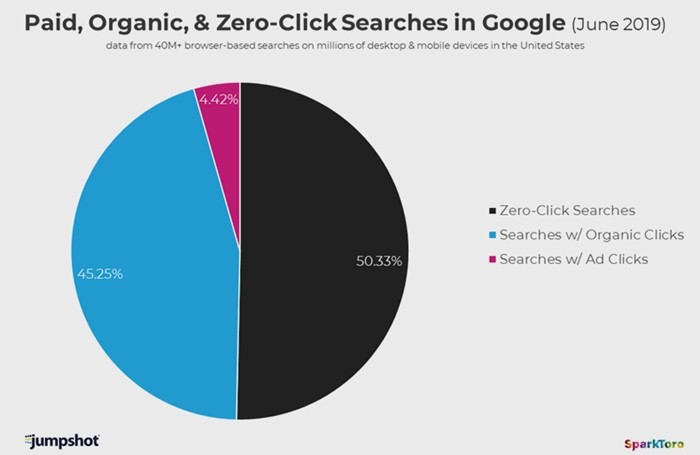
Companies need to be aware of how this zero-click phenomenon affects organic search and what can be done to maintain healthy streams of traffic to their websites.
Positioning your site to receive traffic organically from every opportunity that arises should be a top priority in your company's marketing strategy.
How to Adapt to Zero-Click and Dwindling Search Traffic
There used to be a simplistic layout for Google's SERPs: a few Google Ads at the top of the page, followed by 10 organic results. Now, as search engines have become more adept at deciphering the true intent of searches, there is a myriad of Google features that are displayed depending on the nature of the search.
Throughout this article we'll use a search for the keyword "french press" as our example. That search turns up four Google features before the first organic result: The SERP displays a video carousel, shopping image, a PAA box, the local pack, and then the first search result not "owned" by Google.
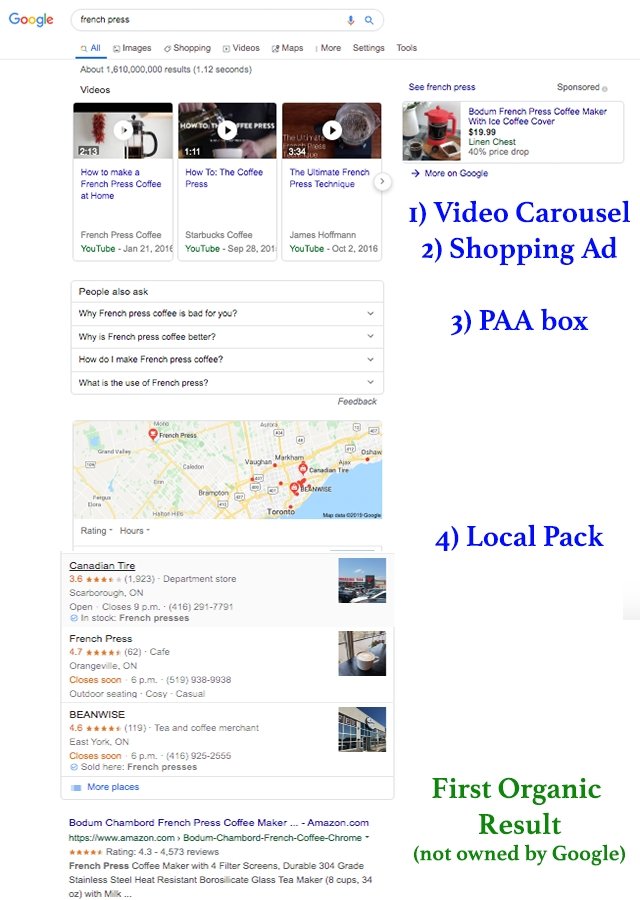
What's to be done? Here are a few tactics marketers can use to keep a steady stream of visitors to their sites.
1. Capture traffic from local searches
Over the past few years, 46% of all searches are searches made to acquire local information.
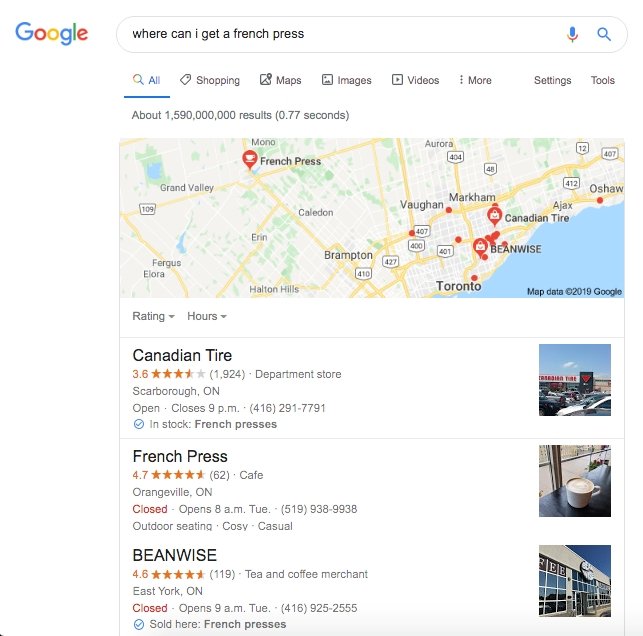
As a result, Google's local pack is triggered and is present for almost half of all searches. If you're not optimized to perform on Google My Business, you are losing traffic to this product.
2. Win the featured snippet
The featured snippet was introduced years ago, and its presence has increasingly become prevalent in queries. The featured snippet is the first thing a user sees when it is present in the search results, and so it will instantly absorb available results page clicks.
Certain types of snippets will cause a zero-click search because they can provide the answer the user is looking for in a paragraph, list, or table.
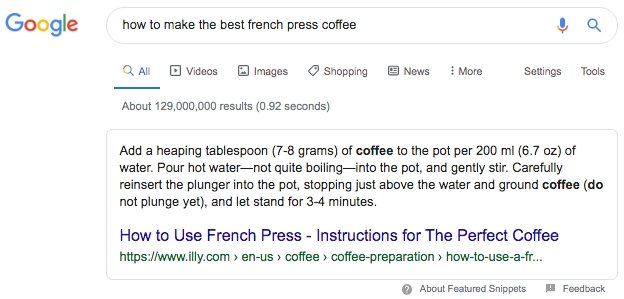
For informational queries where users require more detail, the snippet provides websites with an opportunity to capitalize on driving more traffic. This list snippet encourages a clickthrough by listing more than eight list items, forcing the click to see the entire list.
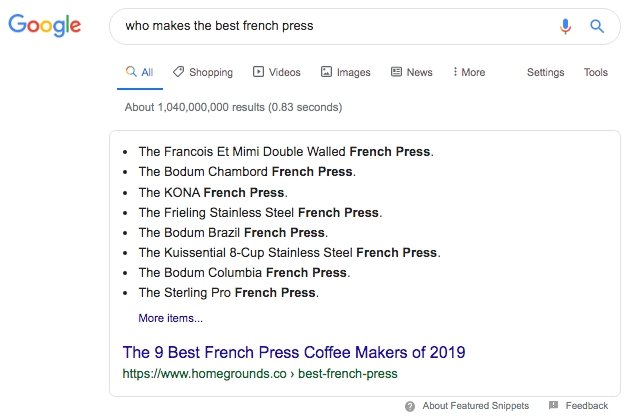
According to a study by Ahrefs in 2017, the snippet essentially steals traffic from the No. 1 position.
The emergence of Google SERP features has added an additional consideration to selecting the best keywords for your business: If a snippet exists on the results page, you need to consider whether it completely answers the query and therefore results in a zero-click search. If so, the keyword isn't worth any traffic to your site because it has a low organic clickthrough rate.
And if there is a large organic clickthrough rate, the consideration becomes a question of how to win the snippet in order to maximize your traffic opportunity.
3. Optimize for PAA boxes
One of the more subtle yet potentially pervasive products that have led to the decline of organic traffic has been the People Also Ask box. These Google products consist of three or four related questions that are displayed in the box. If you click on one, three more appear. The additional questions that appear for every click are endless and virtually push the organic listings further and further down the page.
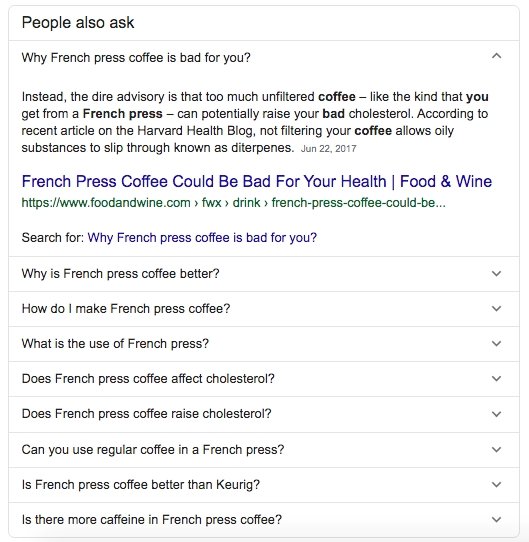
Although the PAA boxes are stout contributors to the traffic kept on Google-owned properties, they also represent traffic opportunities to those who have accepted the reality of Google's growing walled garden.
Your website can be optimized to be featured for the questions and answers found in PAA boxes. Just as the featured snippets can be won, so can a position in the PAA box by simply optimizing your page with the correct HTML and structured data mark-up.
PAA boxes appear in approximately 90% of all searches, which means you can't afford to overlook these opportunities to increase traffic to your site.
4. Identify and optimize for other SERP features that drive traffic
Some 20 Google SERP features are commonly displayed on results pages. Each one is designed to answer search intent more accurately and to improve user experience. There is no going back at this stage, and we can only expect more instances of how Google will continue to keep users clicking on Google-owned properties and products.
As marketers and business owners, we need to accept the current state of search and adapt by implementing the strategies that currently drive traffic.
Capitalize on the opportunities that are present by using Google's features to your advantage. Diversifying the sources of traffic that your site produces is a solution to preserving your traffic in the case of changes to the organic ranking algorithm.
5. Find alternative sources of traffic
Use video in your marketing strategy to build a more recognizable brand and generate additional traffic from YouTube. Because people prefer video, 89% of marketers are now using video as part of their marketing strategy.

It has become more common for users to search YouTube for product reviews or learn how to perform a task. Choose keywords in cases where you can answer search intent with a video and build a channel based on providing your audience with solutions to that keyword's related problems.
Tigerfitness.com transformed its entire business by catering to its clients on YouTube. It became a way to beat giants like Amazon that don't offer the same level of customer service and personalized attention to questions and issues related to their products. The company achieved a 60% returning customer rate, attributing that success to personalization through high-value videos in content marketing campaigns.
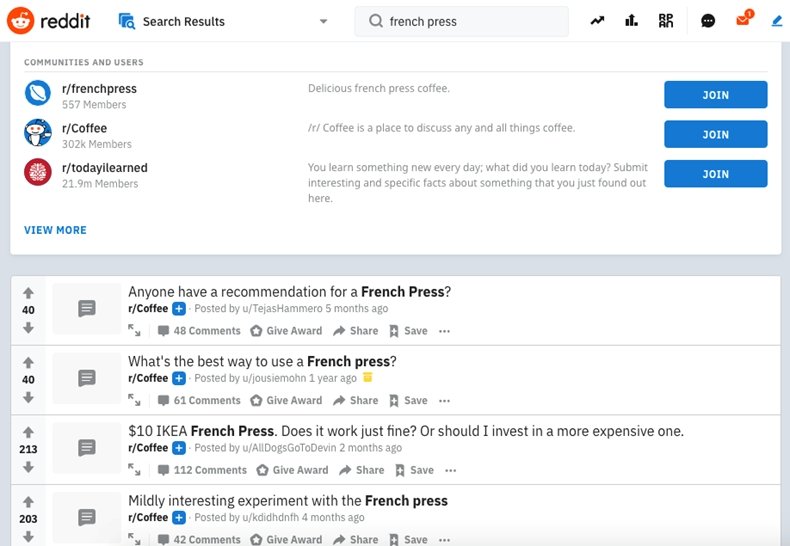
Choose one social media profile to build a social network. Trying to manage multiple profiles will dilute your efforts to be responsive. To build a network of followers, you will need to not only post your own content but also share other members' content.
Many businesses thrive from the traffic social media provides, so incorporating it into your overall marketing plan diversifies your traffic and strengthens your ability to generate new clients.
6. Google-proof your traffic with email marketing
Put more emphasis on preserving your current clients and visitors by creating a strong email marketing campaign. This Google-proof strategy is low-cost, and it provides one of the best returns on investment in marketing, boasting an average of $44 for every $1 spent.
Your email marketing strategy can encourage repeat visits, repeat purchases, and follow up with a higher level of customer service. No matter what changes or updates are made to search engines, they won't affect the traffic you can drive from an email list.
Keep Adapting and Adjusting
Analytic thinking and smart and adaptive marketing are more important now than ever. Although we are experiencing a decline in the organic click-through rate, traffic opportunities exist to hedge losses. It's important to recognize where these opportunities exist for your company and how you can capitalize.
Diversify your sources of traffic for long-lasting results—attracting visitors that convert to leads and new clients.




